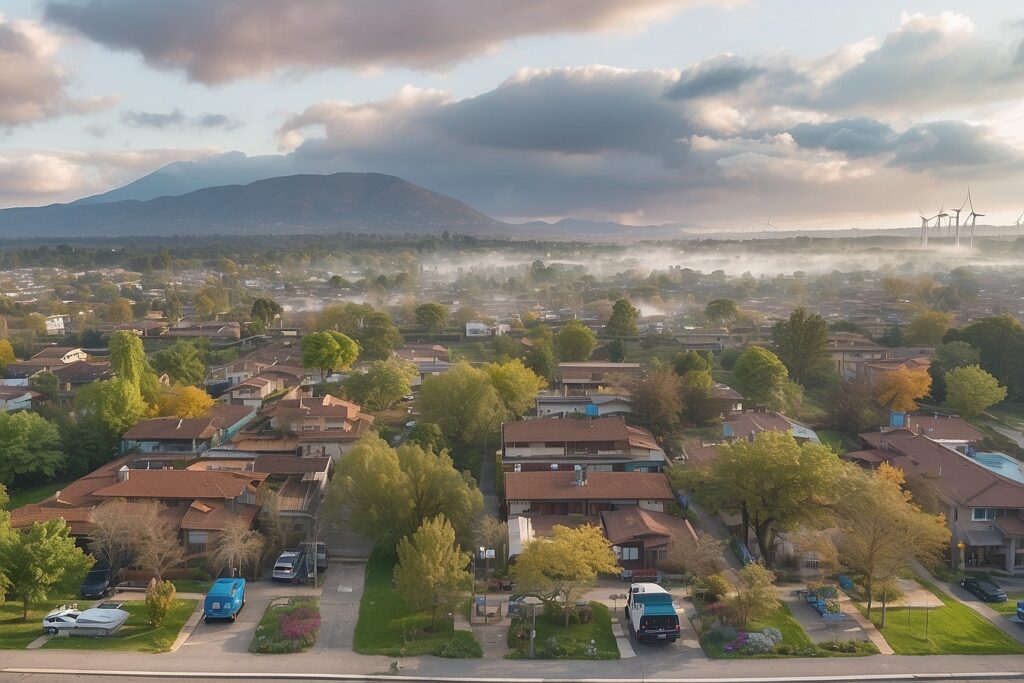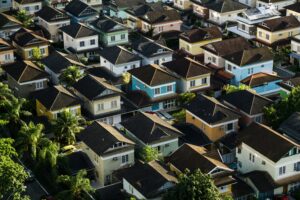Escaping the Inferno: A Personal Journey of Climate Migration

Randall’s tale echoes the experiences of many who have found themselves at the mercy of the intensifying impacts of climate change. In the year 2020, as flames licked at the edges of his suburban home in San Francisco, he and his wife were faced with a terrifying ultimatum.
The wildfire, driven by soaring temperatures and exacerbated by hazardous air quality, posed a direct threat to their safety and livelihoods. Images of neighboring homes succumbing to the inferno served as a stark reminder of the fragility of their situation.
Fortunately, Randall’s home was spared from the wrath of the wildfire. However, the harrowing experience served as a catalyst for a life-altering decision. After more than two decades in California, Randall and his wife made the difficult choice to uproot their lives and seek refuge elsewhere.
In late 2020, they became what Randall terms “climate refugees,” bidding farewell to the golden state and embarking on a journey across the country to Webster, NY.
For Randall, the move offered more than just a fresh start; it provided a sense of security in the face of an uncertain future. Nestled in the tranquility of a small town near the Canadian border, they found solace in their newfound surroundings. The proximity to their aging parents served as an added bonus, offering reassurance during times of upheaval.
Reflecting on his decision, Randall, now 71 and enjoying retirement after a career in software development, expresses a mix of relief and disbelief. I just thought this was way out of control, he recalls, recounting the moments of fear and uncertainty as the wildfire raged perilously close to their home.
There was one time when the winds were blowing south and [the fire] was about 20 miles from us… I was like, ‘What the heck are we going to do?’ Because it moves so fast and the winds are blowing, and it’s over 100 degrees.
Randall’s story serves as a poignant reminder of the human cost of climate change. As extreme weather events become increasingly commonplace, individuals and communities alike are forced to confront the realities of a warming planet. For Randall and countless others, the decision to relocate represents not only a means of self-preservation but a testament to the resilience of the human spirit in the face of adversity.
Navigating Climate Risks: How Environmental Threats Impact U.S. Housing Market
A recent report from the Realtor.com® economics team unveils a sobering reality: nearly half of all homes in the United States, amounting to 44.8%, face the looming specter of severe or extreme damage from environmental hazards.
This revelation, underscored by the staggering figure of almost $22 trillion in residential real estate at risk, paints a dire picture of the vulnerability of American communities to flooding, wind damage, wildfires, heatwaves, and hazardous air quality.
The urgency of this issue has been brought to the forefront by recent events, such as the unprecedented wildfire ravaging Texas earlier this month. The Smokehouse Creek Fire, deemed the largest in the state’s history, has left a trail of devastation in its wake. With at least two fatalities, over 500 structures obliterated, and more than 1 million acres scorched as of March 2, the catastrophe serves as a grim reminder of the destructive power of climate-related disasters.

Realtor.com economist Jiayi Xu emphasizes the significance of climate risk, highlighting its multifaceted impact on home values, insurance premiums, and the overall stability of housing markets. The repercussions extend beyond physical damage, with even unaffected properties feeling the financial strain through elevated insurance costs, jeopardizing potential sales and exacerbating the already daunting challenge of homeownership.
“The issues are whether you can get access to affordable insurance and how much the costs will increase,” Xu explains, echoing the concerns of many homeowners grappling with the evolving landscape of climate-related risks.
For individuals like Randall, who made the difficult choice to relocate in the face of such threats, the decision represents a trade-off between nostalgia for familiar surroundings and prioritizing personal safety. Despite longing for the camaraderie of friends and the natural splendor of California, Randall finds solace in the sense of security afforded by his new abode.
“I wouldn’t go back,” he asserts, underscoring the gravity of his decision and the peace of mind it has afforded him.
To assess the metropolitan areas most susceptible to these risks and quantify the potential impact on property values, the Realtor.com economics team conducted a comprehensive analysis. By integrating data on heat, wildfires, floods, wind patterns, and air quality from First Street Foundation with Realtor.com’s extensive property database, they identified homes in the 100 largest metros facing severe or extreme risk. (Honolulu was excluded from the analysis due to insufficient climate data.)
In a landscape fraught with uncertainty, understanding the intersection of environmental threats and real estate is imperative. As communities grapple with the escalating consequences of climate change, proactive measures and informed decision-making are essential to safeguarding the future of homeownership and preserving the sanctity of home.
A recent report from the Realtor.com® economics team unveils a sobering reality: nearly half of all homes in the United States, amounting to 44.8%, face the looming specter of severe or extreme damage from environmental hazards. This revelation, underscored by the staggering figure of almost $22 trillion in residential real estate at risk, paints a dire picture of the vulnerability of American communities to flooding, wind damage, wildfires, heatwaves, and hazardous air quality.
The urgency of this issue has been brought to the forefront by recent events, such as the unprecedented wildfire ravaging Texas earlier this month. The Smokehouse Creek Fire, deemed the largest in the state’s history, has left a trail of devastation in its wake. With at least two fatalities, over 500 structures obliterated, and more than 1 million acres scorched as of March 2, the catastrophe serves as a grim reminder of the destructive power of climate-related disasters.
Realtor.com economist Jiayi Xu emphasizes the significance of climate risk, highlighting its multifaceted impact on home values, insurance premiums, and the overall stability of housing markets. The repercussions extend beyond physical damage, with even unaffected properties feeling the financial strain through elevated insurance costs, jeopardizing potential sales and exacerbating the already daunting challenge of homeownership.

“The issues are whether you can get access to affordable insurance and how much the costs will increase,” Xu explains, echoing the concerns of many homeowners grappling with the evolving landscape of climate-related risks.
For individuals like Randall, who made the difficult choice to relocate in the face of such threats, the decision represents a trade-off between nostalgia for familiar surroundings and prioritizing personal safety. Despite longing for the camaraderie of friends and the natural splendor of California, Randall finds solace in the sense of security afforded by his new abode.
“I wouldn’t go back,” he asserts, underscoring the gravity of his decision and the peace of mind it has afforded him.
To assess the metropolitan areas most susceptible to these risks and quantify the potential impact on property values, the Realtor.com economics team conducted a comprehensive analysis. By integrating data on heat, wildfires, floods, wind patterns, and air quality from First Street Foundation with Realtor.com’s extensive property database, they identified homes in the 100 largest metros facing severe or extreme risk. (Honolulu was excluded from the analysis due to insufficient climate data.)
In a landscape fraught with uncertainty, understanding the intersection of environmental threats and real estate is imperative. As communities grapple with the escalating consequences of climate change, proactive measures and informed decision-making are essential to safeguarding the future of homeownership and preserving the sanctity of home.
Unveiling the Wildfire Vulnerability: Colorado Springs Leads the Charge in High-Risk Real Estate
The vast expanse of the Western United States has emerged as the epicenter of a relentless wildfire crisis, leaving devastation in its wake and shaking communities to their core.
Recent data underscores the stark reality of the threat, revealing that a staggering 5.5% of homes nationwide, amounting to a staggering $3 trillion in value, are teetering on the edge of severe or extreme risk from wildfires. These properties face a daunting probability of over 14% of being engulfed by flames within the next three decades, painting a grim picture of the perilous landscape confronting homeowners across the country.
Nowhere is this vulnerability more palpable than in states like California, where approximately 39% of these high-risk properties are situated.
The escalating risk has prompted a growing exodus of insurers from fire-prone regions, leaving homeowners grappling with a dwindling pool of affordable options. For those bound by mortgage agreements mandating insurance coverage, the situation has become even more dire, with traditional avenues proving increasingly elusive.
In the absence of viable alternatives, many homeowners have turned to California’s FAIR Plan, the insurer of last resort. However, this fallback option often comes with a hefty price tag, further straining already stretched budgets and exacerbating the financial burden on households already reeling from the impacts of wildfires.
Despite the looming threat and mounting challenges, there exists a paradoxical trend: home prices in the very areas most susceptible to wildfires continue to soar. These regions, predominantly concentrated along the coveted West Coast, are witnessing unprecedented growth in property values, defying conventional wisdom and underscoring the complex interplay between risk perception and market dynamics.
As policymakers, homeowners, and insurers grapple with the multifaceted implications of this crisis, urgent action is imperative to mitigate the looming threat of wildfires and safeguard the sanctity of communities at risk. From bolstering resilience measures to fostering greater collaboration between stakeholders, addressing this existential threat demands a concerted effort and unwavering commitment to protecting lives and livelihoods in the face of adversity.

Colorado Springs, CO, emerges as a focal point in the conversation surrounding wildfire vulnerability, with a staggering 74.4% of homes in the metropolitan area facing severe or extreme risk over the next three decades. This alarming statistic translates to approximately $89.9 billion worth of real estate poised precariously on the brink of potential devastation.
The scars of past infernos serve as poignant reminders of the ever-present threat looming over Colorado Springs. In 2012, the Waldo Canyon Fire unleashed havoc, claiming the lives of two individuals and laying waste to approximately 350 homes on the city’s west side. The following year, the Black Forest Fire ravaged northern Colorado Springs, leaving in its wake a trail of destruction that included the loss of two lives and nearly 500 homes.
Despite these harrowing experiences, the specter of wildfires has failed to permeate the consciousness of homebuyers in certain parts of the metro, according to local real estate agent Dominic Pucci of Blockhouse Real Estate. For many, the risk remains a distant concern, relegated to the forested expanses further north.
“It’s not really on our radar,” remarks Pucci, underscoring the nuanced perceptions of wildfire risk within the community. “The more north you go into the forested areas, that would be more of a concern.”
Colorado Springs leads a disconcerting lineup of vulnerable metros, with Riverside, CA, trailing closely behind with 61.3% of homes at risk. Tucson, AZ, and Oxnard, CA, follow suit with 59.8% and 41.6% of homes in jeopardy, respectively, while Denver rounds out the list at 30.3%.
As communities grapple with the relentless march of wildfires, understanding the nuances of risk perception and vulnerability is imperative. From bolstering resilience measures to fostering greater awareness and preparedness among residents, proactive steps are essential to safeguarding lives and livelihoods in the face of an ever-evolving threat landscape.
Colorado Springs, CO, emerges as the epicenter of a wildfire vulnerability crisis, with a staggering 74.4% of homes in the metro area teetering on the brink of severe or extreme risk over the next three decades. The cumulative value of real estate in harm’s way amounts to a daunting $89.9 billion, underscoring the magnitude of the threat facing homeowners in the region.
The specter of wildfires looms large over Colorado Springs, with tragic reminders of past devastation etched into the city’s collective memory. In 2012, the Waldo Canyon Fire unleashed havoc, claiming two lives and devouring approximately 350 homes on the city’s west side. A year later, the Black Forest Fire wreaked havoc once again, leaving two fatalities and reducing around 500 homes to ashes in its relentless path of destruction.
Despite these harrowing experiences, local real estate agent Dominic Pucci asserts that wildfires have largely faded from the radar of homebuyers in other parts of the metro area. According to Pucci, who is affiliated with Blockhouse Real Estate, concerns about wildfire risk are primarily confined to the forested northern reaches of the region.
“It’s not really on our radar,” Pucci remarks, emphasizing the localized nature of wildfire apprehension. “The more north you go into the forested areas, that would be more of a concern.”
Following closely on the heels of Colorado Springs, Riverside, CA, emerges as the next hotspot of wildfire vulnerability, with 61.3% of homes facing risk. Tucson, AZ, follows suit with 59.8% of homes at risk, while Oxnard, CA, and Denver trail behind with 41.6% and 30.3% of homes at risk, respectively.
As communities grapple with the escalating threat of wildfires, proactive measures and informed decision-making are imperative to mitigate risks and safeguard the sanctity of homes and livelihoods. From bolstering resilience measures to fostering greater awareness and collaboration, addressing wildfire vulnerability demands a concerted effort and unwavering commitment to protecting vulnerable communities across the nation.

Unveiling the Menace: Trillions in Real Estate Grapple with the Perils of Flooding
A staggering 6.6% of homes in the United States, collectively valued at an estimated $3.4 trillion, find themselves precariously perched on the precipice of a looming flood threat, casting a shadow of uncertainty over communities nationwide.
The specter of flooding transcends mere property damage, posing a grave risk to lives, livelihoods, and the very fabric of affected communities. From tragic loss of life to the devastation of homes and the insidious spread of harmful mold, the consequences of flooding are far-reaching and profound.
Yet, the repercussions extend beyond the physical realm, with the mere specter of flooding exacting a heavy toll on homeowners and prospective buyers alike. Research underscores the enduring impact on property values, revealing that homes situated in flood-prone areas consistently lag behind their counterparts in safer locales.
Moreover, the financial burden borne by homeowners in flood-prone regions is substantial, with high annual insurance premiums adding to the already mounting costs. Data from the National Flood Insurance Program paints a sobering picture, indicating that homeowners enrolled in the program could witness a doubling of their annual premiums by the decade’s end.
As communities grapple with the escalating threat of flooding, proactive measures and informed decision-making are imperative to mitigate risks and safeguard the sanctity of homes and livelihoods. From bolstering infrastructure to fostering greater awareness and resilience, addressing the menace of flooding demands a concerted effort and unwavering commitment to protecting vulnerable communities across the nation.
New Orleans, a city scarred by the indelible memory of Hurricane Katrina in 2025, stands at the forefront of a harrowing battle against the threat of flooding, with a staggering 76.1% of homes, collectively valued at an estimated $78.3 billion, teetering on the brink of severe or extreme danger, according to a recent Realtor.com analysis. This revelation serves as a sobering reminder of the precarious existence confronting residents in the Big Easy, where the specter of flooding looms large and the scars of past devastation run deep.
The gravity of the situation extends beyond the confines of New Orleans, with other coastal communities grappling with their own vulnerability to flooding. Cape Coral, FL, emerges as the next hotspot, with 39.9% of homes facing risk, followed closely by North Port, FL, at 20.2%. Honolulu and Tampa, FL, round out the top five, with 19.5% of homes in each city at risk.
In the face of such peril, the resilience of homeowners and prospective buyers is put to the test. Jesse Keenan, a sustainable real estate professor at Tulane University in New Orleans, offers a candid assessment of the prevailing sentiment, noting, “Buyers are willfully ignorant. You have to push it out of your mind in New Orleans that during hurricane season… you could very easily be wiped off the map.”

As communities grapple with the escalating threat of flooding, proactive measures and informed decision-making are imperative to mitigate risks and safeguard the sanctity of homes and livelihoods. From bolstering infrastructure to fostering greater awareness and resilience, addressing the menace of flooding demands a concerted effort and unwavering commitment to protecting vulnerable communities across the nation.
Dual Threat: Flood-Risk Homes Also Vulnerable to Hurricane Wind Damages
The intertwining perils of flood risk and hurricane wind damages pose a formidable challenge for homeowners in storm-prone regions across the United States. Recent findings reveal that homes facing the highest flood risk from storms are also prime targets for wind damage, with a staggering 18% of properties at risk of severe or extreme damage from hurricane winds exceeding 51 mph over the next three decades. This alarming statistic translates to nearly $7.7 trillion worth of real estate hanging precariously in the balance, underscoring the magnitude of the threat confronting vulnerable communities.
Compounding the challenge is the financial burden borne by homeowners in these high-risk areas. In 19 states and Washington, DC, many homeowners are compelled to carry additional hurricane-related insurance policies, further inflating the cost of homeownership, particularly for buyers relying on traditional mortgages where extra insurance is often mandated. This disparity leaves many homeowners exposed to substantial financial risks in the event of a storm, as water infiltration propelled by wind or damage to roofs typically falls outside the coverage scope of flood insurance policies.
Nowhere is the threat more acute than in the bustling metropolitan areas of the South, particularly coastal cities in Florida. From Houston to Miami, Tampa to Orlando, and Jacksonville to New Orleans, every home in these regions faces a severe or extreme risk of wind damage, amplifying the vulnerability of residents and highlighting the urgent need for proactive measures.
Jesse Keenan, a leading expert in sustainable real estate at Tulane University, sheds light on the struggles faced by homeowners in these high-risk areas. “Buyers are having a hard time finding insurance and then finding insurance they can afford,” Keenan remarks, underscoring the widespread challenges faced by homeowners navigating the complex landscape of insurance coverage. “For everybody else, they just go uninsured,” he adds, painting a stark picture of the difficult choices confronting homeowners in storm-prone regions.
As communities grapple with the dual threat of flood risk and hurricane wind damages, proactive measures and informed decision-making are imperative to mitigate risks and safeguard the sanctity of homes and livelihoods. From bolstering resilience measures to fostering greater awareness and collaboration, addressing these multifaceted challenges demands a concerted effort and unwavering commitment to protecting vulnerable communities across the nation.
Beyond the Thermometer: The Escalating Perils of Rising Temperatures
Rising temperatures are no longer merely an inconvenience; they have evolved into a potent threat in numerous regions across the United States, exacting a toll that is both financial and, at times, fatal.
A staggering one-third of U.S. homes, totaling an estimated $13.6 trillion in value, find themselves ensnared in the grip of severe or extreme heat exposure. With average temperatures in the hottest month of the year poised to exceed a sweltering 95 degrees Fahrenheit over the next three decades, the specter of heat-related risks looms large, particularly for residents in the South. States such as Florida, South Carolina, Texas, and Louisiana emerge as epicenters of vulnerability, with residents grappling with the dual challenges of rising temperatures and the attendant repercussions.
The financial strain imposed by heat is palpable, with renters and homeowners alike bearing the brunt of higher cooling costs. Long-term exposure to scorching temperatures can exact a further toll on property maintenance, with roofs, patios, and retaining walls requiring costlier upkeep to withstand the relentless onslaught of heat.
Nowhere is the heat-related threat more pronounced than in the sweltering environs of the South. From Houston to Miami, Tampa to Orlando, and Jacksonville to New Orleans, every home in these regions confronts a high risk of heat, underscoring the pervasive nature of the challenge and the urgent need for adaptive strategies.
Greg Nino, a seasoned real estate agent in the Houston area affiliated with Re/Max Compass, offers a candid assessment of the region’s struggles. “It can be hell here sometimes,” Nino acknowledges, capturing the visceral reality of life in a region plagued by searing temperatures. “People either leave because they can’t stand it here or they learn to adapt and adjust somehow,” he adds, highlighting the resilience of residents in the face of adversity.
As communities grapple with the escalating perils of rising temperatures, proactive measures and adaptive strategies are imperative to mitigate risks and safeguard the well-being of residents. From implementing heat mitigation measures to fostering greater awareness and resilience, addressing the multifaceted challenges posed by rising temperatures demands a concerted effort and unwavering commitment to protecting vulnerable communities across the nation.
The Invisible Threat: Poor Air Quality’s Impact on Homeowners and Communities

While not as overt as wildfires or flooding, poor air quality poses a significant threat to homeowners and communities across the United States, with far-reaching implications for health and well-being. Approximately 9% of homes, valued at a staggering $6.6 billion, find themselves grappling with severe or extreme risks associated with deteriorating air quality, exacerbated by wildfires, droughts, and extreme heat events.
Nowhere is the impact of poor air quality more pronounced than in California, a state plagued by wildfires and perennially grappling with air pollution woes. The Golden State claims the dubious distinction of harboring the highest percentage of homes at risk, underscoring the pervasive nature of the challenge confronting residents.
Despite the health risks posed by poor air quality, many homebuyers and renters are willing to tolerate these hazards in exchange for more affordable housing options, notes Jiayi Xu of Realtor.com.
In areas with high climate risk and lower home prices, the trade-off between affordability and environmental hazards becomes increasingly apparent, with residents weighing the benefits of reduced housing costs against the potential health consequences of poor air quality.

The Western United States emerges as a hotspot of poor air quality, with four metropolitan areas—Fresno, Spokane, Sacramento, and Stockton—facing severe or extreme risks due to air pollution. Silicon Valley’s San Jose, CA, and Portland, OR, also grapple with alarmingly high risks, with nearly 99.8% of homes in these regions at risk.
As communities grapple with the invisible threat of poor air quality, proactive measures and informed decision-making are imperative to mitigate risks and safeguard the health and well-being of residents. From bolstering air quality monitoring and mitigation efforts to fostering greater awareness and resilience, addressing the multifaceted challenges posed by deteriorating air quality demands a concerted effort and unwavering commitment to protecting vulnerable communities across the nation.




hey there and thank you for your info – I’ve definitely picked up something
new from right here. I did however expertise several technical points using this web site, as
I experienced to reload the site many times previous to I
could get it to load correctly. I had been wondering
if your hosting is OK? Not that I am complaining, but slow loading instances times will often affect your
placement in google and could damage your high-quality score if advertising and marketing with Adwords.
Anyway I’m adding this RSS to my e-mail and can look out
for much more of your respective exciting content. Make sure
you update this again soon.. Escape rooms
Hi just wanted to give you a quick heads up and let
you know a few of the pictures aren’t loading properly.
I’m not sure why but I think its a linking issue. I’ve tried
it in two different browsers and both show the same outcome.
my homepage – webpage